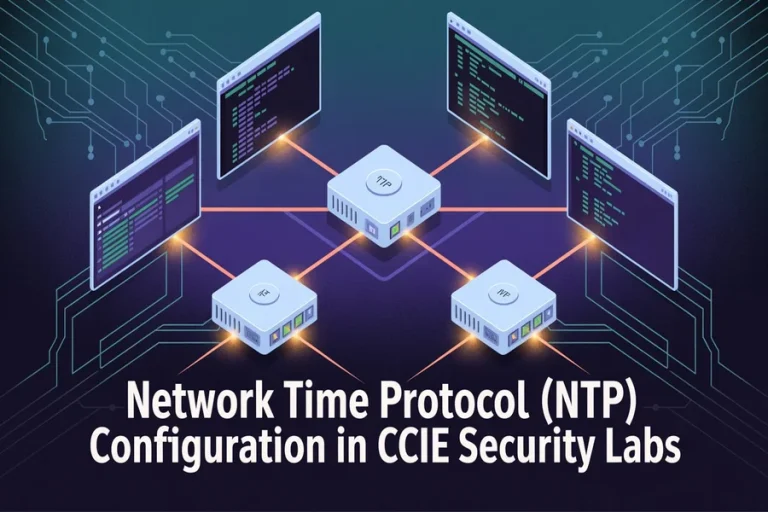Network Time Protocol (NTP) plays a vital role in maintaining accurate time synchronization across all network devices in both enterprise and lab environments. In security-focused networks, precise timing is critical for validating certificates, authenticating users, enforcing security policies, and ensuring accurate log correlation. A small discrepancy in time settings can disrupt critical operations and security mechanisms.
In the context of CCIE Security training, NTP is not just a background service—it’s a foundational element for advanced configurations like VPN authentication, Cisco ISE integration, and syslog analysis. A misconfigured NTP setup in your lab can cause unexpected failures, making it essential to understand both the theory and behavior of NTP in detail.
Why NTP Matters in Security-Centric Networks
NTP ensures that all network devices are time-aligned with either an internal or external reference clock. The protocol runs over UDP port 123 and operates using a hierarchy of stratum levels, where lower stratum values indicate closer proximity to the reference time source. Most lab setups simulate a stratum 2 or 3 NTP server using a router, while devices such as firewalls, Cisco ISE, and syslog servers act as NTP clients.
In security environments, the role of synchronized time becomes important in several ways:
- Certificate-Based Authentication: Certificates used in VPNs and web security require accurate device time to be validated.
- AAA Protocols: RADIUS and TACACS+ rely on time to track session start and end points correctly.
- Log Analysis: Correlation of logs from multiple devices for threat detection and troubleshooting depends on consistent time.
- Policy Controls: Time-based access policies, such as login restrictions, require synchronized time to function correctly.
Typical NTP Deployment Scenario in CCIE Security Labs
In a CCIE Security lab, you will typically work in a closed environment where one device (usually a router) is configured as the NTP server, and other devices are configured as NTP clients. Here’s a high-level view of a typical topology:
| Device | Role | Function in NTP Setup | |
| Router R1 | NTP
Server |
Acts as the authoritative time source within the lab (e.g.,
Stratum 3) |
|
| Cisco
Firewall |
ASA | NTP Client | Synchronizes its clock for accurate logs, VPN timestamps, and alerts |
| Cisco ISE Node | NTP Client | Syncs time for policy enforcement, certificate validation, and profiling | |
| Syslog Server | NTP Client | Relies on accurate time for event logging and correlation | |
All client devices synchronize their system clocks with the router, which acts as the lab’s local time authority. Authentication keys may be used to secure the time exchange, which is considered best practice and often evaluated indirectly in CCIE exam scenarios.
Key Benefits of Configuring NTP in Your Lab
Understanding and configuring NTP in your CCIE lab environment gives you more than just correct timestamps—it enhances the overall operational integrity of your security configurations. Some benefits include:
- Consistent Certificate Validity: VPN tunnels using digital certificates won’t fail due to skewed device time.
- Accurate Forensic Analysis: In case of troubleshooting or threat detection, logs across devices will align properly.
- Reliable Syslog Management: Logs from firewalls, ISE, routers, and switches can be centrally managed and correlated.
- Smooth ISE Integrations: Time drift can cause ISE authentications to fail or be delayed.
- Exam Readiness: Helps avoid indirect failures in VPN, AAA, or logging tasks during the CCIE lab exam.
Best Practices for Secure and Effective NTP
Implementation
When preparing for your CCIE lab or working in production environments, adhere to these best practices:
- Always Use NTP Authentication: Secure NTP communication using authentication keys to avoid spoofing or tampering.
- Use Redundant NTP Servers: Configure at least two NTP servers to maintain time sync in case of device failure.
- Specify Source Interfaces: Ensure devices use the correct and most secure interface to send and receive NTP packets.
- Control Access: Limit which clients can query or synchronize with your NTP server using access control methods.
- Monitor Status Regularly: Check NTP sync status periodically to ensure continued alignment, especially before starting lab tasks.
Verification of NTP Synchronization
Once the configuration is complete, verification is essential. If devices are not synchronized, many downstream features may fail silently, leading to complex troubleshooting. In the CCIE lab, this could cost precious time and points.
Use available platform-specific verification commands or GUI dashboards to ensure:
- Devices are in sync with the defined NTP server.
- Authentication (if configured) is functioning correctly.
- The reported stratum levels make sense within your lab hierarchy.
- Log timestamps across devices align properly.
In real enterprise deployments, many security issues are traced back to poor time synchronization, making this a non-trivial configuration even outside the lab context.
Common Troubleshooting Scenarios
Several issues can prevent successful NTP synchronization in labs:
- Device Clocks Out of Range: If the client device’s clock is too far off, it may reject synchronization.
- UDP Port 123 Blocked: Firewalls or ACLs might block the traffic needed for NTP to function.
- Authentication Key Mismatch: If authentication keys differ on the server and client, sync will fail.
- Wrong Source Interface: Devices may send or expect packets on an incorrect interface.
- ISE or ASA Not Updating: Configuration applied in GUI may take time to reflect, or services may need restarting.
Always verify connectivity and check logs for hints. Fixing time sync can often resolve other seemingly unrelated issues.
Conclusion
Network Time Protocol is more than just a background utility—it is a foundational service that ensures seamless coordination between network components. Without synchronized time, features like secure communications, accurate logging, and policy application can break down, creating blind spots in even the most robust configurations.
As part of your CCIE Security preparation, developing a habit of correctly configuring and verifying NTP will improve your lab reliability and readiness. It not only reinforces good network hygiene but also prevents misdiagnosis of unrelated issues caused by time drift. In the exam and real-world deployments, precise timekeeping remains one of the most underestimated pillars of secure and stable networking.

